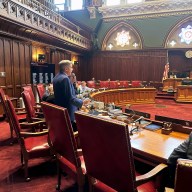EDMONTON – The federal and Alberta governments may have to invest between $1 and $3 billion per year after 2015 to turn the business of capturing carbon into a viable commercial technology.
A report by the Alberta Carbon Capture and Storage Development Council suggests that energy prices could rise as consumers shoulder “a large share of the burden” of the costs of the technology.
But the council, headed by the former president of Syncrude, Jim Carter, concludes that investment in cleaner energy production will help contribute to the province’s prosperity.
Last month, the Alberta government announced that seven companies would share $2 billion to fund three carbon capture and storage projects, to be built by 2015.
They aim to capture carbon dioxide from industrial emissions, including oilsands operations and coal-fired power plants, and inject it deep underground.
“These projects will be insufficient to ensure that the province reaches its longer term greenhouse gas reduction goals, but they will create important momentum,” said the report.
Assuming that oil is selling at about $75 per barrel, there’s the potential to store up to 450 million tonnes of carbon dioxide in conventional oil reservoirs – which could produce an additional 1.4 billion barrels of oil.
The report suggests that could generate a gusher of revenues for the provincial government.
“This incremental production would translate to $105 billion of revenue over the life of the development, potentially generating from $11 to $25 billion in additional provincial royalties and taxes,” the report said.
But the authors warned that carbon capture and storage is not a “silver bullet” and needs to be complemented with policies that include wise energy use and continued efforts to “green” energy production.
It urged the government to put clear regulations and policies in place by the end of this year to ensure there’s a more widespread adoption of this technology.
It could also take up to 20 years to produce such projects on a commercial scale.
The government and industry players also need to invest up to $200 million each year on research and adapting the technology to the province’s needs, the report said.
Oilsands production is expected to almost triple to about three million barrels per day by 2015, at a capital cost of about $80 billion.
“Oilsands (greenhouse gas) emissions would more than double by 2015 without carbon capture and storage implementation,” the report concludes.
It said the technology has the potential to reduce those emissions by 139 million tonnes per year in the oilsands, industrial facilities and in the province’s power sector.
The provincial government has pledged to reduce carbon dioxide emissions by 200 million tonnes in the next 40 years.
Experts have warned that new carbon capture technology will be expensive but it’s needed to make it commercially viable.
Pipelines to carry the carbon dioxide in Alberta alone could cost billions.
Environmental groups have criticized the provincial government for spending billions on what they call an unproven technology.
Groups such as Greenpeace say instead of sinking money into propping up emissions from coal-fired power plants and oilsands operations, government should pump the cash into renewable energy, like solar and wind projects.
















